Using Machine Learning in Business Process Re-Engineering
Abstract
:1. Introduction
- Knowing the fundamentals: What available frameworks, methodologies, tools, and techniques are used in re-engineering a business process?
- Investigating related work: Were there any attempts to automate the business process re-engineering using machine learning?
- Laying out the foundation: what data attributes and datasets are required for a machine-learning model to train and test in order to automate business process re-engineering?
2. Literature Review
2.1. Frameworks
- Mendling framework: distinguishes the re-engineering process into three levels: process relations, process modelling, and process execution and performance [20]. This framework outlines the tasks at each level, segregates the strategic tasks of the implementation process, and illustrates the difference between modelling a business process and using it in daily operations. The framework provides techniques that enable the organisation to identify and model business processes with a prioritisation mechanism. At the process model management level, and because of the impeded continuous improvement concept, new versions of the same business process get released to production between now and then, which requires a reliable way to distinguish running cases based on the process model version. This framework proposes a continuous process improvement in a cycle of tasks that enables the process owner to have visibility on the process performance at all the time with prompt identification for any need for improvement.
- Motwani framework: unlike Mendling, it does not consider having a repository for all business processes as a knowledge pool. Instead, it looks individually at each change requirement. The Motwani framework has six phases:
- Understanding the scope of work.
- Initiating the project with agreed upon and measurable objectives.
- Programming requires baseline and benchmarking.
- Transforming the process from the old version to the new version.
- Implementing the change.
- Evaluating success mapped to the objectives.
- Al-Mashari and Zairi framework is a holistic framework, as they describe it, for business process re-engineering implementation [15]. This framework begins by looking at the internal and external change drivers, then benchmarking to determine the scope of the change, the degree of the change, and the change radicalness. The implementation phase has categorised the tools and techniques into enabling, facilitating, integrating, and implementating the tools and techniques. However, it has a critical gap in evaluating the outcome, as it is not adequately covered. The philosophy of this framework sums up the revolutionary magnitude of change based on breakthrough, one-time, or episodic approaches [22].
- Robert’s framework took the steps very carefully where situational assessments plugged in nearly all stages, forming a continuous improvement process that starts again when it ends. The cycle begins with assessing and analysing the current opportunities and capabilities to propose a redesign, which triggers iterations of risk assessment and impact on the organisation output, a transition plan is made, and pilot testing conducted. This will give either the confidence to go ahead with the new process design and amend improvements, or corrections will be made to the proposed process with iterations to improve it before implementing the change in the production environment. When all tests pass the requirements, the framework recommends implementing the required modifications before implementing and transitioning to the new process. As a final stage, Robert’s framework closely tracks the recent process performance and reinitiates the cycle again for further improvement. However, using practical change management tools to manage the resistance to change is a factor for failure or success of the business process re-engineering projects [23].
- Lowenthal’s framework is a simple and basic framework of four phases [15], with a high-level sequence of steps:
- Preparing for the change.
- Planning.
- Redesigning the process.
- Evaluating the change.
- The simplicity in this framework does not give much attention to analysing the need for the process redesign or benchmarking in depth. After implementing the change, it does not explicitly cover phases, such as testing, training, organisation change, and process performance monitoring. In general, Lowenthal’s framework will not work for massive and complicated process redesign projects that require more details and focus. Instead, it is more suitable for implementing small incremental changes.
- The Cross framework distinguishes the tasks into three main phases (Analysis, Design, and Implementation) with a detailed list of the activities in each stage. The analysis phase covers the requirements analysis part very well. It gives explicit attention and consideration to the consumer requirements and makes changes driven by the customer needs, which provides more value and relevancy to the customer. In addition, it impacts the assessment of changes and their success or failure. Baseline analyses and current process reviews are also used with the customer requirements to build a 3-dimensional view of the design specifications. In the design phase, Cross et al. introduced a list of design principles helping the redesign team qualify the design options at a high level of design. This produces a detailed re-engineered design for the process. The new design is then injected into cycles of testing involving clients, in order to get their feedback until it achieves a satisfactory level and consensus agreement on the new process. The new process will then be moved to the implementation phase to transform the business into the new process. However, the Cross et al. framework does not address the impact on process performance after the implementation. Similarly, it does not address the continuous improvement concept [15].
- TOGAF (The Open Group Architecture Framework) is a comprehensive framework widely used in industry to manage information technology architecture in complex environments with impeded continuous improvement concepts. However, the study did not find any relevant academic research implementation for business process redesign, optimisation, or improvement research. This might be because TOGAF is an information technology framework applied to improve information technology architecture and performance, which is an opportunity, as information technology empowers business processes. [24]
2.2. Methodologies
- Lean methodology began with a manufacturing emphasis and was referred to as lean manufacturing for many years. Gradually, organisations learned that the same principles also applied to non-manufacturing processes [27]. John Y. Shook, and the Lean Global Network team [28], emphasise that Lean creates the most value for the customer while minimising resources, time, energy, and effort.
- The Six Sigma methodology was initially founded by Motorola, when facing extreme pressures from overseas competition, mainly Japan. Therefore, around 1987, Bill Smith and others began improvement projects that, in many ways, looked similar to TQM projects. Eventually, Mikel Harry and others helped Smith formulate this approach into an overall business initiative to protect Motorola’s pager business. They named the initiative “Six Sigma”. The name was based on the desire to reduce variation to the level that specification limits for in crucial process metrics, six standard deviations away from the target [27]. General Electric also played a very significant role in the development of Six Sigma as a methodology. General Electric CEO JackWelch loudly proclaimed that General Electric was jumping into the Six Sigma game in late 1995. Jack Welch defines Six Sigma as a quality program that, “when all is said and done”, improves customer experience, lowers costs, and builds better leaders [27,29]. The Six Sigma methodology starts with identifying the need for an improvement initiative. However, when Motorola designed the initial version of the Six Sigma steps, it replaced the four phases of Measure, Analyse, Improve, and Control by General Electric. It did not have the Defining step. The Define phase was added before the Measure phase afterwards, in order to form the well-known Define, Measure, Analyse, Improve, and Control process (DMAIC) [27,29]. However, when a product or a service is under significant design change requirements or at an early stage of development, the five phases of Six Sigma change to Define, Measure, Analyse, Design, and Verify (DMADV). The change is to achieve a Six Sigma level right from the initial design, which is also called the Design For Six Sigma (DFSS) [27,29]. The Six Sigma methodology is a well-disciplined and structured approach used to enhance process performance and achieve high quality and low levels of variability [29].
- Lean Six-Sigma methodology eliminates waste and variation, following the DMAIC structure, as in the Six Sigma methodology, to achieve customer satisfaction regarding quality, delivery, and cost. In addition, it focuses on improving processes, satisfying customers, and achieving better financial results for the business [29].
- Kaizen, as a term, was coined by Masaaki Imai, as “KAI” means changes, and “ZEN” means improvement. The focus of the Kaizen methodology is to eliminate the activities that do not add value to the process [30].
2.3. Tools and Techniques
2.4. Success Factors
2.5. Data Mining and Machine Learning Use in Business Process Management
3. Findings
4. Discussion
- Process industry, e.g., aviation, telecommunication, manufacturing, and banking
- Process function, e.g., human resources, finance, supply chain, and production
- Process versions of history; the process version opens another dimension of the prediction model of the alternative process design.
- Activity performance against its KPIs: poor, good, and excellent. This attribute can be more accurate when the KPIs data are available.
- Activity operation cost value (acceptable? Yes or no).
- Customer satisfaction level (from one to five); some companies implement customer satisfaction at each step.
- Does it make a bottleneck? (Yes or no).
- Are there enough resources to do the task? (Yes or no).
- Is it digitalised? (Yes or no).
- Can it be automated? (Yes or no).
- Is it an audit compliance check step? (Yes or no).
- Is it being performed by the same actor as the previous step in the process? (Yes or no).
- Activity value to the process (1–10)? If less than three, should it be eliminated?
- How relevant is the activity to the process objectives? (Relevant or irrelevant).
- Is it a service provided to customers step? (Yes or no).
- Is it an internal activity or does it require external input? Internal is meant in the sense of the organisation, specifically, the function department.
- Stakeholder level. (VIP, owner, consumer, employee, and system).
- Is it business-to-business or business-to-customer?
- Process modelling repository
- Process execution data
- Process events logging database
- Process performance KPIs
- Process owner feedback
- Experienced process engineer decision
5. Conclusions
Author Contributions
Funding
Institutional Review Board Statement
Informed Consent Statement
Data Availability Statement
Conflicts of Interest
References
- Sujová, A.; Simanová, L.; Marcineková, K. Reengineering of production processes and its impact on the financial situation and business performance of the company. Eng. Manag. Prod. Serv. 2019, 11, 106–116. [Google Scholar] [CrossRef] [Green Version]
- Tsakalidis, G.; Vergidis, K. Towards a Comprehensive Business Process Optimization Framework. In Proceedings of the 2017 IEEE 19th Conference on Business Informatics (CBI), Thessaloniki, Greece, 24–27 July 2017; IEEE: Piscataway, NJ, USA, 2017; Volume 1, pp. 129–134. [Google Scholar] [CrossRef]
- Harmon, P. Business Process Change: A Business Process Management Guide for Managers and Process Professionals; Morgan Kaufmann Publishers: Burlington, MA, USA, 2019. [Google Scholar]
- Brocke, J.V.; Mendling, J. Frameworks for business process management: A taxonomy for business process management cases. In Business Process Management Cases; Springer: New York, NY, USA, 2017; pp. 1–17. [Google Scholar] [CrossRef]
- Van der Aalst, W.M. Process Mining: Data Science in Action; Springer: New York, NY, USA, 2016. [Google Scholar]
- Burattin, A. Process Mining Techniques in Business Environments; Springer: New York, NY, USA, 2015. [Google Scholar]
- Karagiannis, D.; Woitsch, R. Knowledge engineering in business process management. In Handbook on Business Process Management 2; Springer: New York, NY, USA, 2014; pp. 623–648. [Google Scholar] [CrossRef]
- Hitpass, B.; Astudillo, H. Industry 4.0 Challenges for Business Process Management and Electronic-Commerce. J. Theor. Appl. Electron. Commer. Res. 2019, 14. [Google Scholar] [CrossRef] [Green Version]
- Fakorede, O. SNACH A New Framework to Support Business Process Improvement. Ph.D. Thesis, Bournemouth University, Poole, UK, 2020. [Google Scholar]
- Cadavid, J.P.U.; Lamouri, S.; Grabot, B.; Fortin, A. Machine Learning in Production Planning and Control: A Review of Empirical Literature. IFAC PapersOnLine 2019, 52, 385–390. [Google Scholar] [CrossRef]
- Eliakina, N. Digital Transformation: Identifying areas for process optimization in Credit Management department, Case Corporation X. Ph.D. Thesis, Vaasaan Ammattikorkeakoulu University of Applied Sciences, Vaasa, Finland, 2018. [Google Scholar]
- Gupta, S.; Modgil, S.; Gunasekaran, A. Big data in lean six sigma: A review and further research directions. Int. J. Prod. Res. 2019, 58, 947–969. [Google Scholar] [CrossRef]
- Bako, Y.; Banmeke, M. The impact of business process re-engineering on organizational performance (A study of commercial banks and micro-finance banks in Ilaro). J. Manag. Technol. 2019, 5, 1–14. [Google Scholar]
- Hashem, G. Organizational enablers of business process reengineering implementation. Int. J. Product. Perform. Manag. 2019, 69, 321–343. [Google Scholar] [CrossRef]
- Bhaskar, H.L. Business process reengineering framework and methodology: A critical study. Int. J. Serv. Op. Manage. 2018, 29, 527–556. [Google Scholar]
- Saltz, J.S.; Dewar, N. Data science ethical considerations: A systematic literature review and proposed project framework. Ethic- Inf. Technol. 2019, 21, 197–208. [Google Scholar] [CrossRef]
- Cirne, R.; Melquiades, C.; Leite, R.; Leijden, E.; Maciel, M.A.A.; de Lima Neto, F.B. Data Mining for Process Modeling: A Clustered Process Discovery Approach. In Proceedings of the 15th Conference on Computer Science and Information Systems (FedCSIS), Sofia, Bulgaria, 6–9 September 2020. [Google Scholar]
- Freiesleben, J.; Keim, J.; Grutsch, M. Machine learning and Design of Experiments: Alternative approaches or complementary methodologies for quality improvement? Qual. Reliab. Eng. Int. 2020, 36, 1837–1848. [Google Scholar] [CrossRef]
- Watton, R. Project Management Framework: A Structure for All Organisations; PMF Management Solutions: Logan, Australia, 2015. [Google Scholar]
- Mendling, J.; Baesens, B.; Bernstein, A.; Fellmann, M. Challenges of smart business process management: An introduction to the special issue. Decis. Support. Syst. 2017, 100, 1–5. [Google Scholar] [CrossRef]
- Chountalas, P.T.; Lagodimos, A.G. Paradigms in business process management specifications: A critical overview. Bus. Process. Manag. J. 2018, 25, 1040–1069. [Google Scholar] [CrossRef]
- Binci, D.; Belisari, S.; Appolloni, A. BPM and change management: An ambidextrous perspective. Bus. Process Manag. J. 2019, 26. [Google Scholar] [CrossRef]
- Bhasin, S.; Dhami, S. Business Process Reengineering–The Role of Human Resource Function: A Comprehensive Review of Literature. Int. J. Bus. Manag. Res. 2018, 8036, 1–18. [Google Scholar]
- Harrison, R. Togaf (r) 9 Foundation Study Guide; Van Haren: Hertogenbosch, The Netherlands, 2018. [Google Scholar]
- Joslin, R. Project Management Methodologies, Governance and Success: Insight from Traditional and Transformative Research; CRC Press: Boca Raton, FL, USA, 2019. [Google Scholar]
- Zaini, Z.; Saad, A. Business Process Reengineering as the Current Best Methodology for Improving the Business Process. J. ICT Educ. 2019, 6, 66–85. [Google Scholar] [CrossRef]
- Antony, J.; Snee, R.; Hoerl, R. Lean Six Sigma: Yesterday, today and tomorrow. Int. J. Qual. Reliabil. Manag. 2017, 34, 1073–1093. [Google Scholar] [CrossRef]
- Shook, J.Y. Lean Global Network. What is Lean Thinking and Practice? 2018. Available online: http://leanglobal.org/what-is-lean/ (accessed on 7 March 2021).
- Salah, S.; Rahim, A. The integration of six sigma and lean. In An Integrated Company-Wide Management System; Springer: New York, NY, USA, 2019; pp. 49–93. [Google Scholar] [CrossRef]
- Goyal, A.; Agrawal, R.; Chokhani, R.K.; Saha, C. Waste reduction through Kaizen approach: A case study of a company in India. Waste Manag. Res. 2018, 37, 102–107. [Google Scholar] [CrossRef]
- Es-Soufi, W.; Yahia, E.; Roucoules, L. On the Use of Process Mining and Machine Learning to Support Decision Making in Systems Design. In Proceedings of the IFIP 13th International Conference on Product Lifecycle Management, Colombia, SC, USA, 11–13 July 2016; Springer: New York, NY, USA, 2016; pp. 56–66. [Google Scholar] [CrossRef]
- Marquez-Chamorro, A.E.; Resinas, M.; Ruiz-Cortes, A. Predictive Monitoring of Business Processes: A Survey. IEEE Trans. Serv. Comput. 2017, 11, 962–977. [Google Scholar] [CrossRef]
- Bergner, M.; Johannsen, F.F. Supporting business process improvement with natural language processing: A model-based approach. Informatik 2016, 2016, 717–730. [Google Scholar]
- Buer, S.-V.; Fragapane, G.I.; Strandhagen, J.O. The Data-Driven Process Improvement Cycle: Using Digitalization for Continuous Improvement. IFAC Papers OnLine 2018, 51, 1035–1040. [Google Scholar] [CrossRef]
- Zgodavova, K.; Bober, P.; Majstorovic, V.; Monkova, K.; Santos, G.; Juhaszova, D. Innovative Methods for Small Mixed Batches Production System Improvement: The Case of a Bakery Machine Manufacturer. Sustainability 2020, 12, 6266. [Google Scholar] [CrossRef]
- Weichert, D.; Link, P.; Stoll, A.; Rüping, S.; Ihlenfeldt, S.; Wrobel, S. A review of machine learning for the optimization of production processes. Int. J. Adv. Manuf. Technol. 2019, 104, 1889–1902. [Google Scholar] [CrossRef]
- Omidi, A.; Khoshtinat, B. Factors Affecting the Implementation of Business Process Reengineering: Taking into Account the Moderating Role of Organizational Culture (Case Study: Iran Air). Procedia Econ. Finance 2016, 36, 425–432. [Google Scholar] [CrossRef] [Green Version]
- AbdEllatif, M.; Farhan, M.S.; Shehata, N.S. Overcoming business process reengineering obstacles using ontology-based knowledge map methodology. Futur. Comput. Informatics J. 2018, 3, 7–28. [Google Scholar] [CrossRef]
- Mannhardt, F.; de Leoni, M.; Reijers, H.A.; van der Aalst, W.M.P. Decision mining revisited-discovering overlapping rules. In Proceedings of the International Conference on Advanced Information Systems Engineering, Yanuca Island Coral Coast Fiji Islands, Fiji, 28 June–2 July 2016; Springer: New York, NY, USA, 2016. [Google Scholar]
- Kalenkova, A.; Burattin, A.; de Leoni, M.; van der Aalst, W.; Sperduti, A. Discovering high-level BPMN process models from event data. Bus. Process. Manag. J. 2018, 25, 995–1019. [Google Scholar] [CrossRef] [Green Version]
- Broucke, S.K.V.; de Weerdt, J. Fodina: A robust and flexible heuristic process discovery technique. Decis. Support. Syst. 2017, 100, 109–118. [Google Scholar] [CrossRef]
- Leemans, S.J.J.; Fahland, D.; van der Aalst, W.M.P. Scalable process discovery and conformance checking. Softw. Syst. Model. 2016, 17, 599–631. [Google Scholar] [CrossRef]
- Verbeek, H.; Mannhardt, F. The Dr Furby Classifier Submission to the Process Discovery Contest@ BPM 2016; BPM Center Report BPM-16-08; BPM Center: San Pedro, CR, USA, 2016. [Google Scholar]
- Evermann, J.; Rehse, J.-R.; Fettke, P. Predicting process behaviour using deep learning. Decis. Support. Syst. 2017, 100, 129–140. [Google Scholar] [CrossRef] [Green Version]
- Neu, D.A.; Lahann, J.; Fettke, P. A systematic literature review on state-of-the-art deep learning methods for process prediction. Artif. Intell. Rev. 2021. [Google Scholar] [CrossRef]
- Tax, N.; Verenich, I.; la Rosa, M.; Dumas, M. Predictive business process monitoring with LSTM neural networks. In Proceedings of the International Conference on Advanced Information Systems Engineering, Essen, Germany, 12–16 June 2017; Springer: New York, NY, USA, 2017. [Google Scholar]
- Chandramouleeswaran, K.R.; Krzemien, D.; Burns, K.; Tran, H.T. Machine Learning Prediction of Airport Delays in the US Air Transportation Network. In Proceedings of the Aviation Technology, Integration, and Operations Conference, Atlanta, GA, USA, 25–29 June 2018. [Google Scholar] [CrossRef]
- Breuker, D.; Hitfox Group; Matzner, M.; Delfmann, P.; Becker, J.; University of Muenster; University of Koblenz-Landau. Comprehensible Predictive Models for Business Processes. MIS Q. 2016, 40, 1009–1034. [Google Scholar] [CrossRef] [Green Version]
- Sammaknejad, N.; Zhao, Y.; Huang, B. A review of the expectation maximization algorithm in data-driven process identification. J. Process. Control. 2019, 73, 123–136. [Google Scholar] [CrossRef]
- Mannhardt, F.; de Leoni, M.; Reijers, H.A.; van der Aalst, W.; Toussaint, P.J. From Low-Level Events to Activities—A Pattern-Based Approach. In Proceedings of the International Conference on Business Process Management, Rio de Janeiro, Brazil, 18–22 September 2016; Springer: New York, NY, USA, 2016; pp. 125–141. [Google Scholar] [CrossRef] [Green Version]
- Lu, X.; Fahland, D.; Andrews, R.; Suriadi, S.; Wynn, M.T.; ter Hofstede, A.H.M.; der Aalst, W. Semi-Supervised Log Pattern Detection and Exploration Using Event Concurrence and Contextual Information (Extended Version); BPM Center report BPM-17-01. In Proceedings of the OTM Confederated International Conferences “On the Move to Meaningful Internet Systems”, Rhodes, Greece, 23–27 October 2017. [Google Scholar]
- Arunkumar, C.; Ramakrishnan, S. Attribute selection using fuzzy roughset based customized similarity measure for lung cancer microarray gene expression data. Futur. Comput. Informatics J. 2018, 3, 131–142. [Google Scholar] [CrossRef]
- Song, Y.-G.; Cao, Q.-L.; Zhang, C. Towards a new approach to predict business performance using machine learning. Cogn. Syst. Res. 2018, 52, 1004–1012. [Google Scholar] [CrossRef]
- Rosalina, R. A Comparison of Machine Learning Algorithms in Manufacturing Production Process. Communication Inf. Technol. J. 2019, 13, 17–23. [Google Scholar] [CrossRef] [Green Version]
- Kratsch, W.; Manderscheid, J.; Reißner, D.; Röglinger, M. Data-driven Process Prioritization in Process Networks. Decis. Support. Syst. 2017, 100, 27–40. [Google Scholar] [CrossRef]
- Denkena, B.; Dittrich, M.-A.; Uhlich, F. Self-optimizing Cutting Process Using Learning Process Models. Procedia Technol. 2016, 26, 221–226. [Google Scholar] [CrossRef]
- Meilicke, C.; Leopold, H.; Kuss, E.; Stuckenschmidt, H.; Reijers, H.A. Overcoming individual process model matcher weaknesses using ensemble matching. Decis. Support. Syst. 2017, 100, 15–26. [Google Scholar] [CrossRef]
- Khan, R.; Azam, F.; Maqbool, B.; Waseem Anwar, M. A Framework for Automated Reengineering of BPMN Models by Excluding Inefficient Activities. In Proceedings of the 9th International Conference on Software and Computer Applications, Langkawi, Malaysia, 18–21 February 2020. [Google Scholar]
- Soto-Acosta, P. COVID-19 Pandemic: Shifting Digital Transformation to a High-Speed Gear. Inf. Syst. Manag. 2020, 37, 260–266. [Google Scholar] [CrossRef]
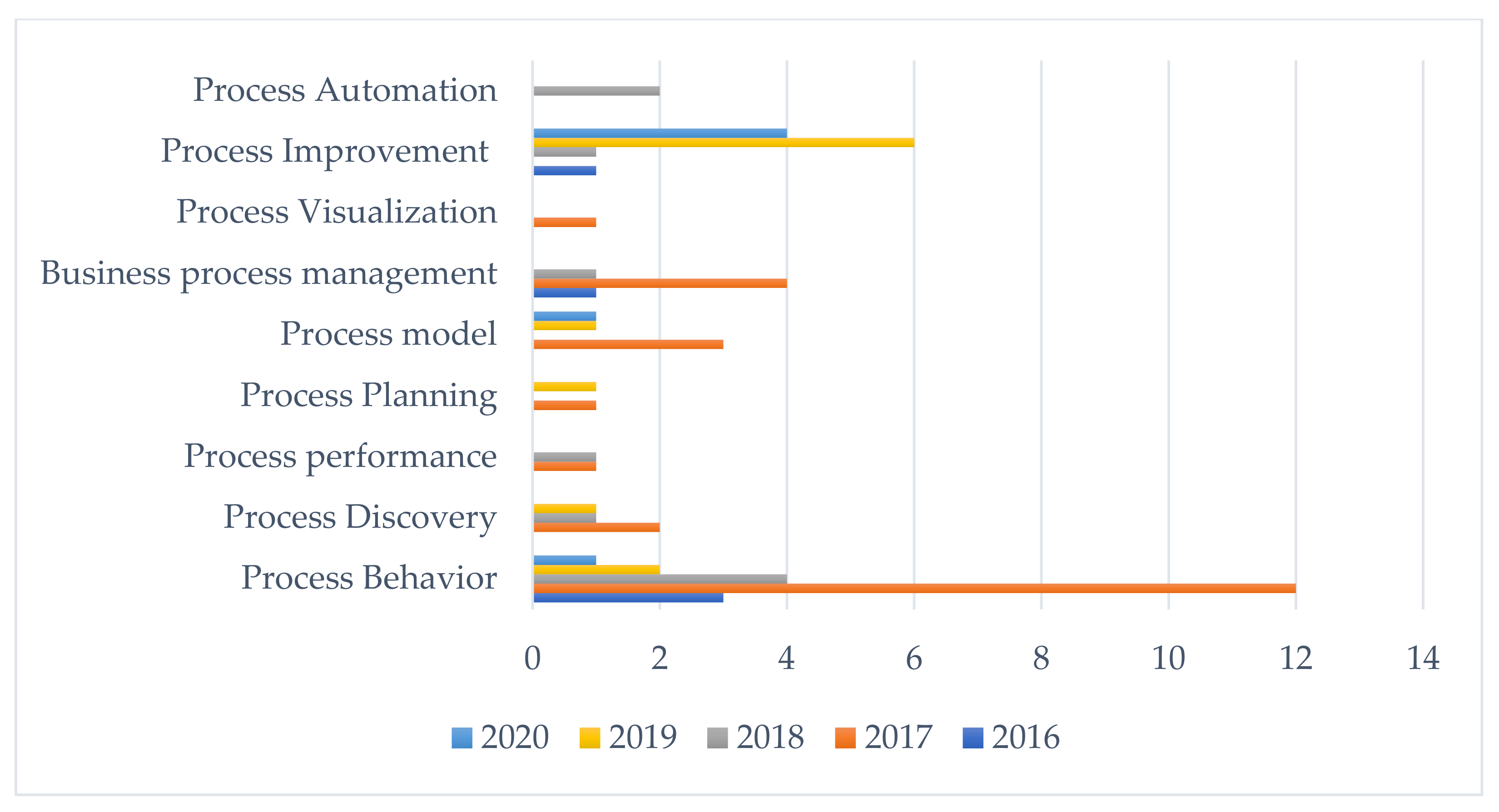
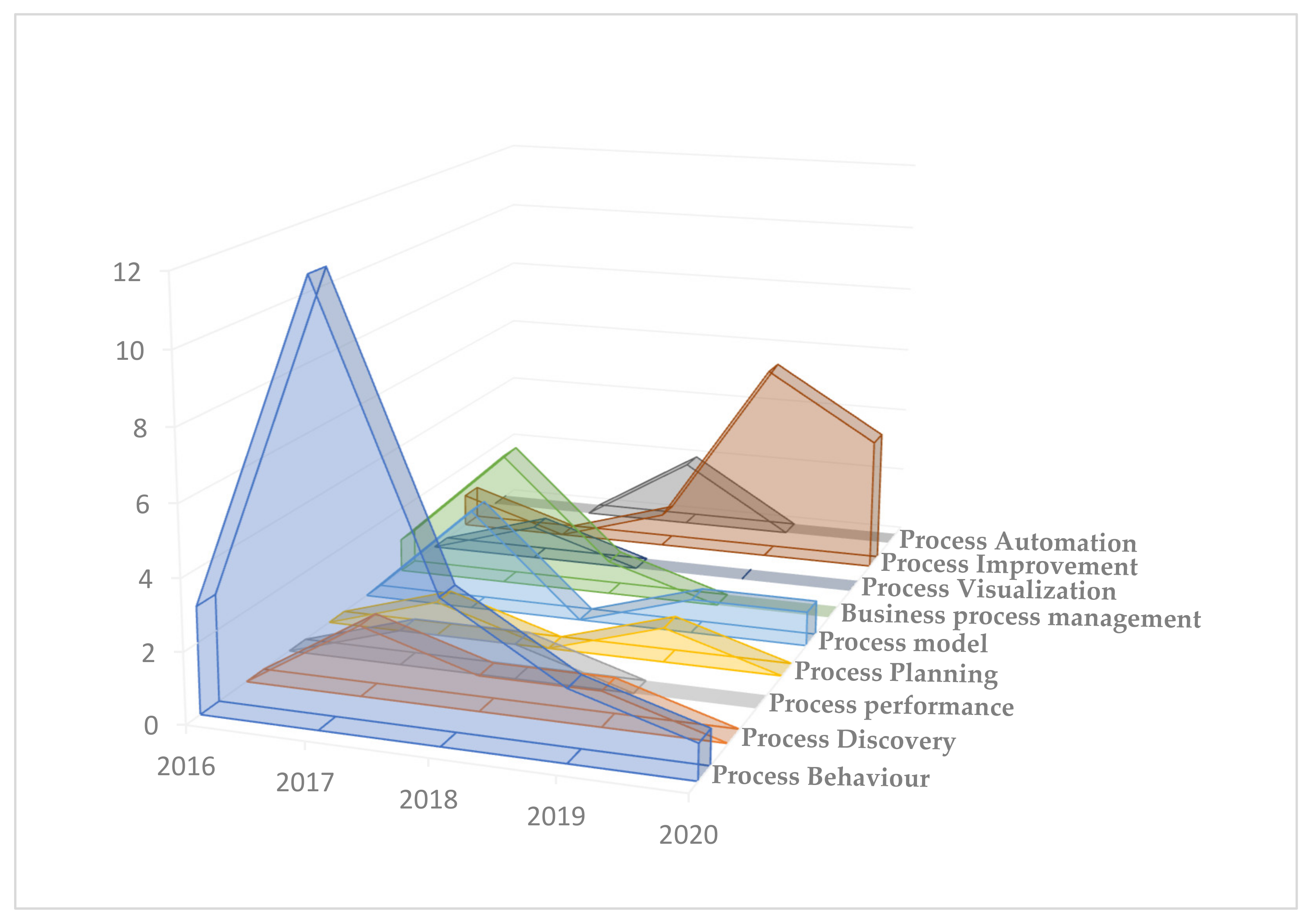
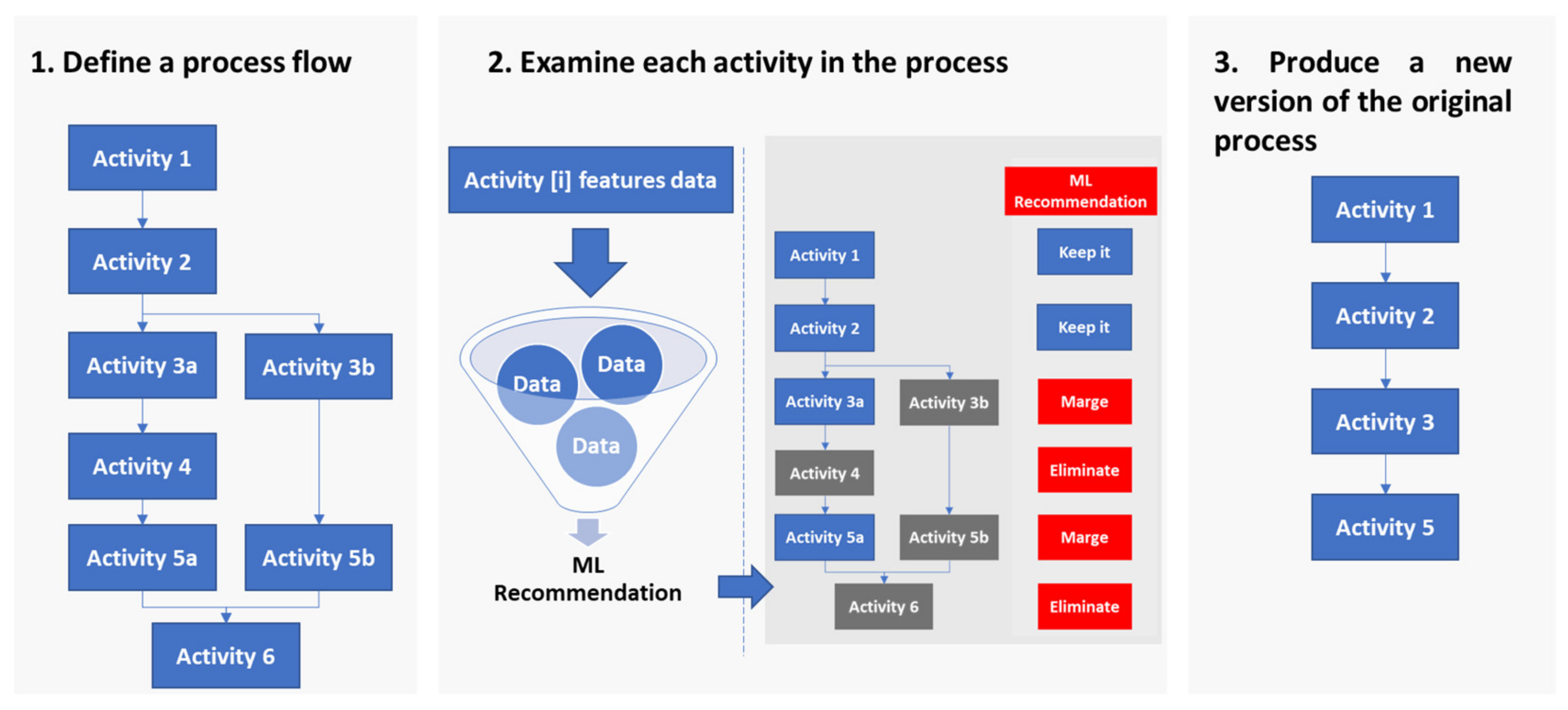
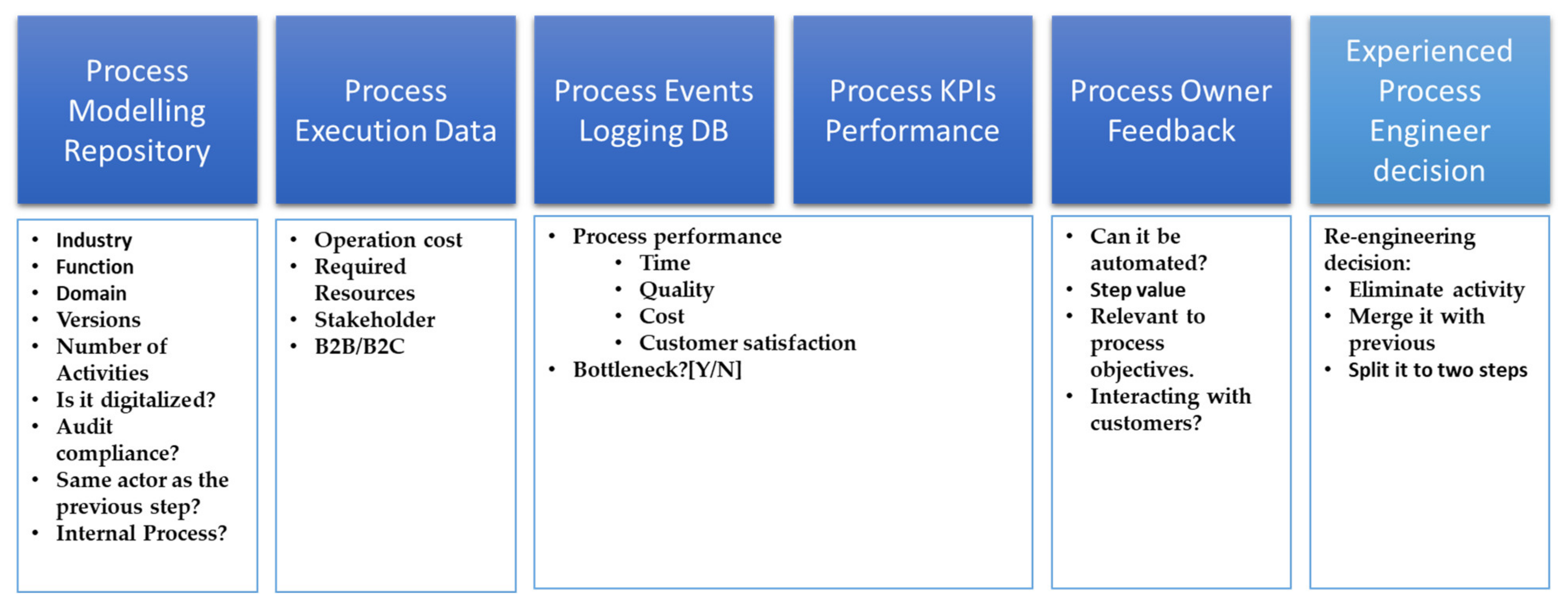
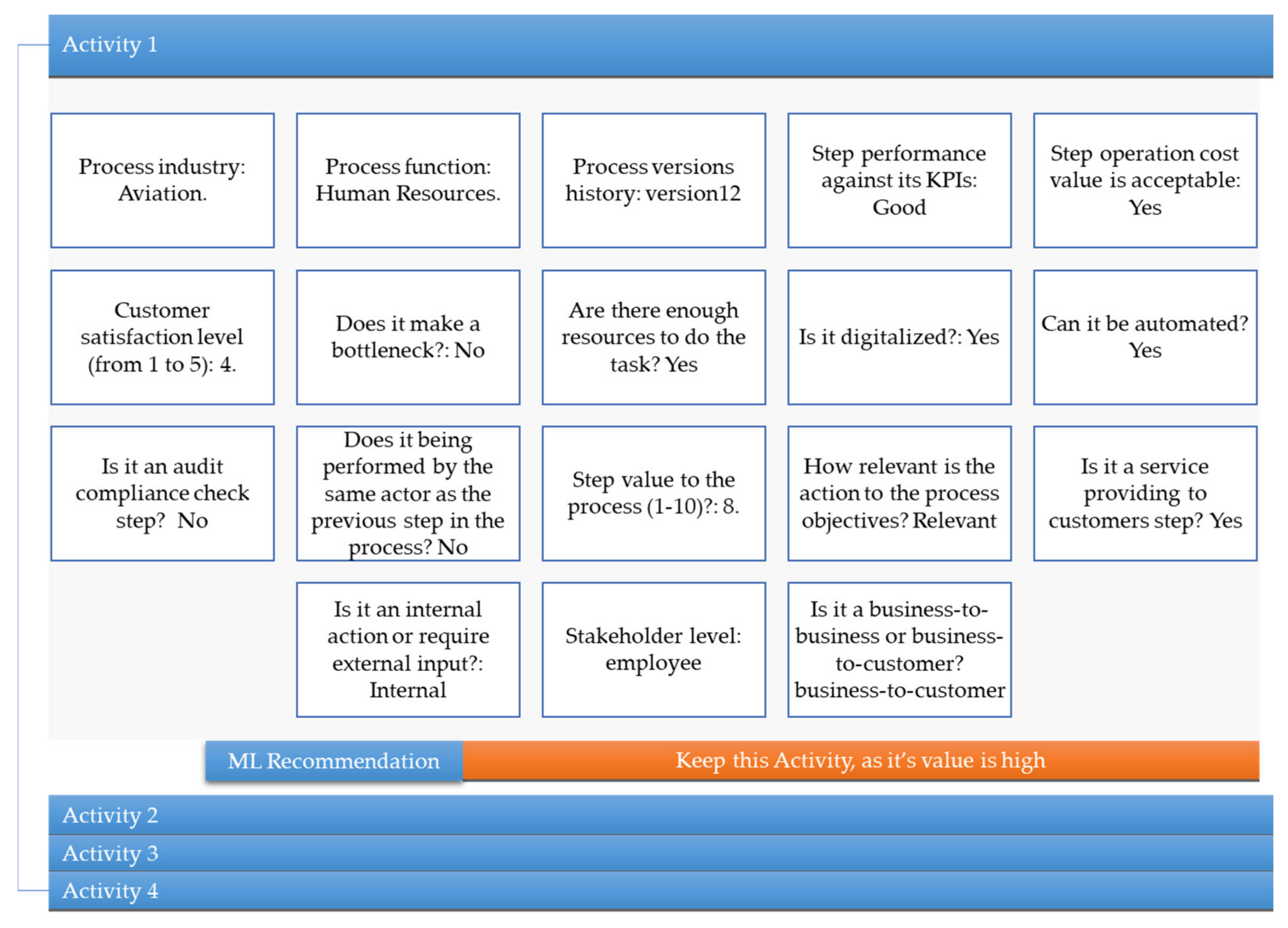
| Framework | Mendling | Motwani | Al-Mashari and Zairi | Robert | Lowenthal | Cross et al. | TOGAF |
|---|---|---|---|---|---|---|---|
| Need analysis and scoping |  |  |  |  |  |  |  |
| Alignment with business strategy |  |  |  |  |  | ||
| Benchmarking |  |  |  |  |  | ||
| Alternative modeling and qualifying |  |  |  |  |  |  |  |
| Organisational change impact |  |  |  |  |  | ||
| Testing end-user engagement |  |  |  |  |  |  | |
| Knowledge management |  |  |  |  | |||
| Handling running instances |  |  |  | ||||
| Process performance monitoring after implementation |  |  |  |  | |||
| Evaluation and setting success factors |  |  |  |  |  |  |  |
| Promoting for continuous improvements |  |  |  | ||||
| Data use in decision making |  |  |  |  |  |  |  |
| Characteristics | Methodologies | |||
|---|---|---|---|---|
| Lean | Six Sigma | Lean Six Sigma | Kaizen | |
| Scope | Eliminating unwanted activities | Reducing variance | Waste elimination and variation reduction | Small and incremental changes |
| Objective | Reduction in workflow time | Process standardisation | Process standardisation and waste reduction | Incremental continuous improvements |
| Use of information technology tools | Very high | Very high | Very high | Intermediate |
| Relying on data in decisions making | High | High | High | High |
| Change method | One time | Incremental | Continuing | Continuing incremental |
| Associated risk levels | High | Moderate | Moderate | Moderate |
| Type | Tools and Techniques | References | ||
|---|---|---|---|---|
| Process discovery and visualizing |
|
|
| [5,31,32,33] |
| Quality management |
|
|
| [26,27,29,33,34,35,36] |
| Analysis |
|
|
| [26,29,36] |
| Category | Factor | Success | Failure |
|---|---|---|---|
| Driver | Alignment of business strategy for BPR project and IT strategies | Aligned strategies | Lack of alignment and unclear strategy |
| Driver | The focus of the change | Driven by customer needs | Focuses on the process as a process and drives the change on structural or pure financial bases |
| Strategic | Clarity on business needs | Solid business case with a clear scope of work | Inadequate business case: unclear, unreasonable, unrealistic scope, and unjustifiable expectations from the BPR project |
| Strategic | BPR methodology and framework | Selecting the best methodology and framework for the project | Lack of innovation in process redesign |
| Strategic | Data empowerment | Data-driven change based on facts and figures | Not having sufficient data |
| Strategic | Change management strategy | Having a solid change management strategy, team, and change processes | Lack of change management |
| Strategic | Top management and critical stakeholders engagement, leadership, and motivation | Highly engaged, supportive, and committed | Lacking support, poor commitment, and poor leadership style |
| Enabler | Operation team engagement | Engaged and involved through the project | Non or minimal engagement |
| Enabler | Technology and digitalisation | Adoptive and change dynamically based on the need | Lack of reliable advanced technology |
| Enabler | Training and education | Provided to all levels | Lack of training and education |
| Enabler | Rewarding system | Fair | Unfair |
| Enabler | Organisation culture | Flat and less bureaucratic Structure | Bureaucratic |
| Enabler | Financial support | Adequate | |
| Enabler | Working environment | Collaborative and work towards shared objectives and targets | Lack of collaborative work |
| Enabler | Communication | Effective communication with all stakeholders | Ineffective communication |
| Enabler | Business process re-engineering team | Authorised, experienced, effective, and skilled | Insufficient authority that lacks experience and skills |
| BPM Task | Algorithm(s) | References |
|---|---|---|
| Process discovery | Decision tree | [32,39,40,41,42,43] |
| Process behaviour prediction | Deep Learning | [32,35,44,45,46,47] |
| Support Vector Machine | [32] | |
| Hidden Markov Model | [32,48] | |
| Expectation–Maximisation | [39,48,49,50,51] | |
| Fuzzy | [52,53] | |
| Process improvement | Natural Language Processing | [33] |
| Decision tree | [32,54] | |
| Process optimisation | Mixed-Integer Linear Programs | [55] |
| Support Vector Machine | [56] | |
| Greedy Algorithm | [57] |
| Step ID. | Performance | Is Bottleneck | Enough Resources | Automated | Audit Step | Same Actor as the Previous or the Next Step | Step Value | Relevant | Prediction Result |
|---|---|---|---|---|---|---|---|---|---|
| 1 | Poor | No | Yes | No | No | No | 6 | Relevant | Keep |
| 2 | Good | Yes | No | No | No | No | 5 | Relevant | Keep |
| 3 | Poor | Yes | Yes | No | Yes | Yes | 2 | Relevant | Merge |
| 4 | Excellent | No | Yes | Yes | No | No | 8 | Relevant | Eliminate |
Publisher’s Note: MDPI stays neutral with regard to jurisdictional claims in published maps and institutional affiliations. |
© 2021 by the authors. Licensee MDPI, Basel, Switzerland. This article is an open access article distributed under the terms and conditions of the Creative Commons Attribution (CC BY) license (https://creativecommons.org/licenses/by/4.0/).
Share and Cite
Al-Anqoudi, Y.; Al-Hamdani, A.; Al-Badawi, M.; Hedjam, R. Using Machine Learning in Business Process Re-Engineering. Big Data Cogn. Comput. 2021, 5, 61. https://doi.org/10.3390/bdcc5040061
Al-Anqoudi Y, Al-Hamdani A, Al-Badawi M, Hedjam R. Using Machine Learning in Business Process Re-Engineering. Big Data and Cognitive Computing. 2021; 5(4):61. https://doi.org/10.3390/bdcc5040061
Chicago/Turabian StyleAl-Anqoudi, Younis, Abdullah Al-Hamdani, Mohamed Al-Badawi, and Rachid Hedjam. 2021. "Using Machine Learning in Business Process Re-Engineering" Big Data and Cognitive Computing 5, no. 4: 61. https://doi.org/10.3390/bdcc5040061
APA StyleAl-Anqoudi, Y., Al-Hamdani, A., Al-Badawi, M., & Hedjam, R. (2021). Using Machine Learning in Business Process Re-Engineering. Big Data and Cognitive Computing, 5(4), 61. https://doi.org/10.3390/bdcc5040061






